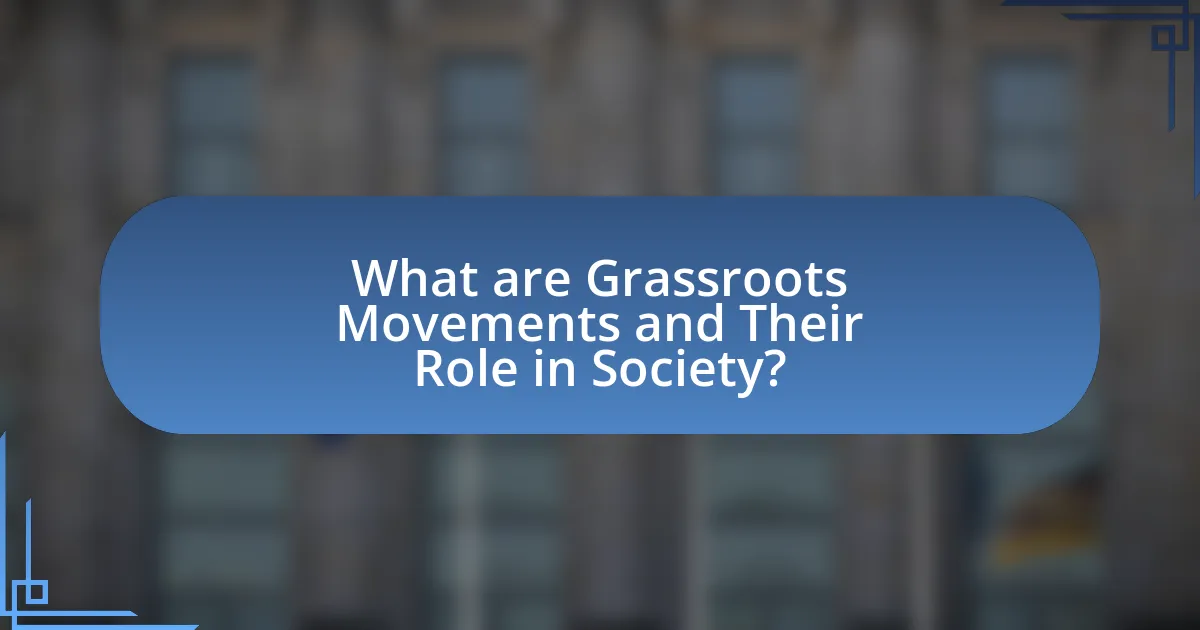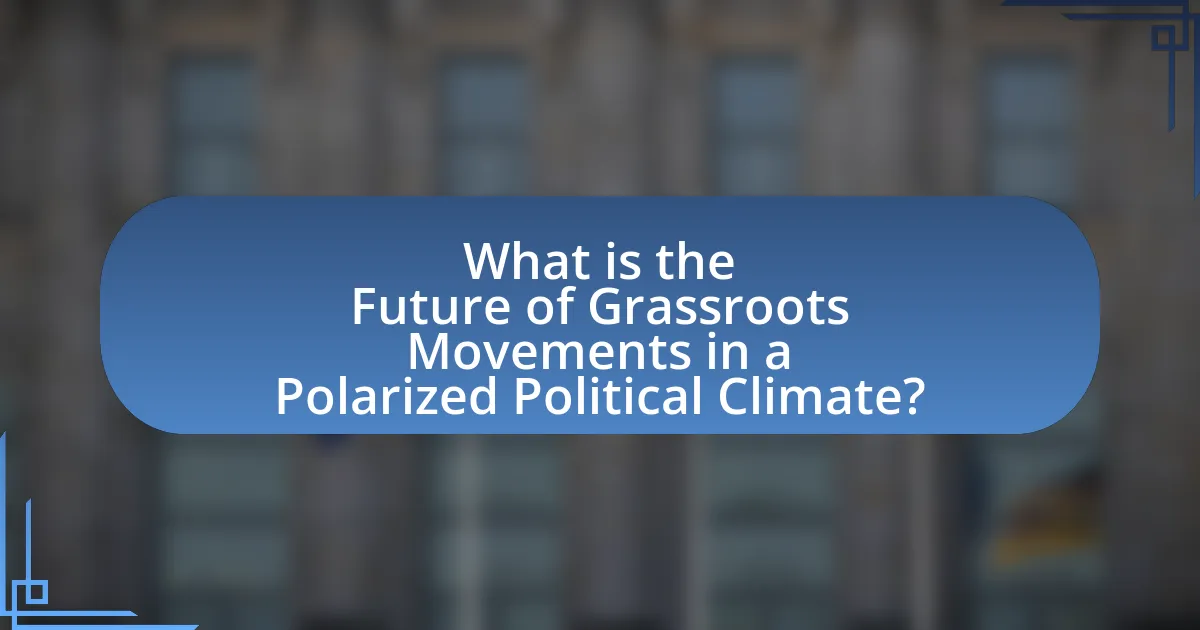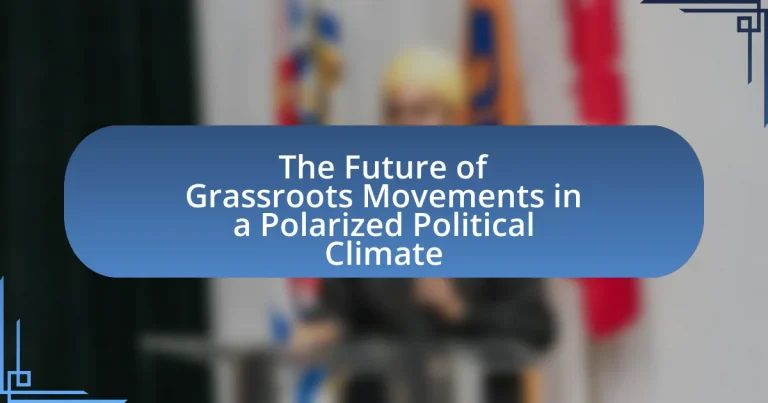Grassroots movements are collective actions initiated by ordinary individuals at the community level to address social, political, or environmental issues. This article examines the role of grassroots movements in society, highlighting their differences from traditional political movements, key characteristics, and their significance in a polarized political climate. It discusses how these movements mobilize community support, enhance political engagement, and address social justice issues while facing challenges such as polarization and misinformation. Additionally, the article explores strategies for overcoming these challenges, the impact of technology, and the future of grassroots movements in adapting to changing political landscapes.

What are Grassroots Movements and Their Role in Society?
Grassroots movements are collective actions initiated by ordinary people at the community level to address social, political, or environmental issues. These movements play a crucial role in society by empowering individuals to advocate for change, influencing public policy, and fostering civic engagement. For instance, the Civil Rights Movement in the United States, which emerged from grassroots efforts, significantly advanced racial equality and led to landmark legislation such as the Civil Rights Act of 1964. Grassroots movements often mobilize resources and support through local networks, making them effective in raising awareness and driving social change from the bottom up.
How do Grassroots Movements differ from Traditional Political Movements?
Grassroots movements differ from traditional political movements primarily in their structure and approach to mobilization. Grassroots movements are typically initiated and sustained by ordinary citizens at the community level, emphasizing local engagement and bottom-up organization, whereas traditional political movements often rely on established political parties, hierarchies, and top-down strategies. For example, the Civil Rights Movement in the United States was largely grassroots, driven by local activists and community leaders, while traditional political movements like the Democratic Party operate through formal institutions and established leadership. This distinction highlights how grassroots movements prioritize direct participation and community involvement, contrasting with the more centralized and institutional nature of traditional political movements.
What are the key characteristics of Grassroots Movements?
Grassroots movements are characterized by their community-driven nature, emphasizing local participation and activism. These movements typically arise from the collective efforts of individuals who share common interests or grievances, often mobilizing around social, political, or environmental issues. They rely on grassroots organizing strategies, which include door-to-door outreach, community meetings, and social media campaigns to build support and raise awareness.
Additionally, grassroots movements often prioritize inclusivity and democratic decision-making, ensuring that all voices within the community are heard and represented. This participatory approach fosters a sense of ownership among members, which can lead to sustained engagement and commitment. Historical examples, such as the Civil Rights Movement in the United States, illustrate how grassroots efforts can effectively challenge systemic injustices and drive significant social change.
How do Grassroots Movements mobilize community support?
Grassroots movements mobilize community support by fostering local engagement and building networks of individuals who share common goals. These movements often utilize social media platforms to disseminate information quickly, organize events, and create a sense of community among supporters. For example, the Black Lives Matter movement effectively used social media to raise awareness and mobilize protests, demonstrating the power of digital communication in rallying community support. Additionally, grassroots movements often emphasize personal stories and local issues, making their messages relatable and urgent, which further galvanizes community involvement.
Why are Grassroots Movements important in a Polarized Political Climate?
Grassroots movements are important in a polarized political climate because they empower individuals and communities to advocate for change from the ground up, fostering engagement and participation in the democratic process. These movements often arise in response to feelings of disenfranchisement, allowing marginalized voices to be heard and mobilizing collective action around shared issues. For instance, the Black Lives Matter movement has significantly influenced public discourse on racial justice and police reform, demonstrating how grassroots initiatives can challenge systemic inequalities and galvanize widespread support. By creating networks of solidarity and encouraging civic involvement, grassroots movements can bridge divides and promote dialogue, which is essential for addressing the complexities of a polarized society.
What impact do Grassroots Movements have on political engagement?
Grassroots movements significantly enhance political engagement by mobilizing individuals at the community level to participate in political processes. These movements often empower marginalized voices, leading to increased voter turnout and advocacy for specific issues. For instance, the Women’s March in 2017 galvanized millions to engage in political discourse and activism, resulting in a notable rise in female candidates in subsequent elections. Research indicates that grassroots efforts can lead to a 20% increase in voter participation in local elections, demonstrating their effectiveness in fostering civic involvement.
How do Grassroots Movements address issues of social justice?
Grassroots movements address issues of social justice by mobilizing community members to advocate for systemic change and raise awareness about inequalities. These movements often focus on local issues, empowering individuals to participate in activism that directly impacts their lives, such as advocating for policy reforms, organizing protests, and creating educational campaigns. For instance, the Black Lives Matter movement has effectively highlighted racial injustices and police brutality, leading to significant policy discussions and changes in various jurisdictions. Additionally, grassroots movements utilize social media platforms to amplify their messages, engage a broader audience, and foster solidarity among diverse groups, thereby enhancing their impact on social justice issues.

What Challenges do Grassroots Movements Face in a Polarized Environment?
Grassroots movements face significant challenges in a polarized environment, primarily due to heightened division and hostility among opposing groups. This polarization often leads to reduced collaboration and increased difficulty in building coalitions, as individuals may be less willing to engage with those who hold differing views. Additionally, grassroots movements frequently encounter obstacles in gaining media attention and public support, as sensationalized narratives dominate the discourse, overshadowing their messages. Research indicates that in highly polarized contexts, movements struggle to mobilize diverse participants, limiting their effectiveness and reach. For instance, a study by the Pew Research Center found that political polarization has intensified since 2016, making it harder for grassroots initiatives to resonate across ideological lines.
How does Political Polarization affect Grassroots Movements?
Political polarization significantly impacts grassroots movements by creating a more divided and contentious environment for mobilization. In highly polarized contexts, grassroots movements often align closely with specific ideological factions, which can enhance their visibility and support among like-minded individuals but may also alienate potential allies from opposing viewpoints. Research indicates that polarization can lead to increased activism within echo chambers, where individuals reinforce their beliefs without engaging in constructive dialogue with those holding differing opinions. For instance, a study by the Pew Research Center found that 55% of Americans believe that political disagreements have become more intense in recent years, which can hinder collaboration across the political spectrum and limit the effectiveness of grassroots initiatives aimed at broader societal change.
What are the barriers to collaboration among different Grassroots Movements?
Barriers to collaboration among different grassroots movements include ideological differences, resource competition, and lack of communication. Ideological differences often lead to conflicting goals and priorities, making it difficult for movements to unite. For example, environmental groups may prioritize climate action while social justice movements focus on equity, creating tension in collaborative efforts. Resource competition arises when movements vie for limited funding and support, which can foster distrust and hinder partnerships. Additionally, lack of communication can result in misunderstandings and missed opportunities for collaboration, as movements may not be aware of each other’s initiatives or objectives. These barriers collectively impede the effectiveness of grassroots movements in achieving common goals.
How do misinformation and media influence Grassroots Movements?
Misinformation and media significantly influence grassroots movements by shaping public perception and mobilizing support or opposition. Misinformation can distort the narrative surrounding a movement, leading to confusion and division among potential supporters, as seen in the spread of false information during the Black Lives Matter protests, which affected public opinion and engagement. Conversely, media coverage can amplify grassroots efforts, providing visibility and legitimacy, as demonstrated by the extensive media attention received by the Women’s March in 2017, which helped mobilize millions globally. Thus, the interplay between misinformation and media can either hinder or enhance the effectiveness of grassroots movements, depending on how narratives are constructed and disseminated.
What strategies can Grassroots Movements employ to overcome these challenges?
Grassroots movements can employ coalition-building and strategic communication to overcome challenges in a polarized political climate. Coalition-building allows these movements to unite diverse groups, enhancing their collective strength and reach. For instance, the Women’s March in 2017 successfully brought together various organizations advocating for women’s rights, demonstrating the power of collaboration. Strategic communication involves crafting clear, relatable messages that resonate with a broad audience, which can help counteract misinformation and polarization. Research by the Pew Research Center indicates that effective messaging can significantly influence public perception and engagement, highlighting the importance of communication strategies in mobilizing support.
How can Grassroots Movements leverage technology for better outreach?
Grassroots movements can leverage technology for better outreach by utilizing social media platforms to amplify their messages and engage with a broader audience. For instance, platforms like Twitter and Facebook allow these movements to share information rapidly, mobilize supporters, and create viral campaigns that can reach millions. According to a study by the Pew Research Center, 69% of adults in the U.S. use social media, making it a vital tool for grassroots organizations to connect with constituents and raise awareness about their causes. Additionally, technology enables the use of data analytics to identify key demographics and tailor outreach efforts effectively, enhancing the impact of their campaigns.
What role does coalition-building play in strengthening Grassroots Movements?
Coalition-building plays a crucial role in strengthening grassroots movements by enhancing their collective power and reach. When diverse groups unite under a common cause, they can pool resources, share knowledge, and amplify their voices, making their advocacy efforts more impactful. For instance, the 2017 Women’s March in the United States brought together various organizations and individuals, resulting in one of the largest single-day protests in U.S. history, demonstrating the effectiveness of coalition-building in mobilizing large numbers of people for social change. This collaboration not only increases visibility but also fosters solidarity among different communities, which is essential in a polarized political climate where divisions can hinder progress.

What is the Future of Grassroots Movements in a Polarized Political Climate?
The future of grassroots movements in a polarized political climate is likely to see increased mobilization and adaptability. Grassroots movements have historically thrived in times of division, as they often emerge from communities seeking to address specific grievances and advocate for change. For instance, the rise of movements like Black Lives Matter and climate activism demonstrates how grassroots efforts can galvanize public support and influence policy, even amidst significant political polarization. Furthermore, research indicates that grassroots organizations can leverage digital platforms to expand their reach and engage diverse demographics, enhancing their effectiveness in a fragmented political landscape. This adaptability and strategic use of technology will be crucial for grassroots movements to sustain momentum and drive social change in the future.
How can Grassroots Movements adapt to changing political landscapes?
Grassroots movements can adapt to changing political landscapes by employing flexible strategies that respond to shifts in public sentiment and policy environments. For instance, they can utilize social media platforms to quickly mobilize support and disseminate information, as seen in movements like Black Lives Matter, which effectively leveraged online tools to amplify their message during critical moments of social unrest. Additionally, grassroots organizations can form coalitions with other groups to broaden their influence and resources, exemplified by the Women’s March, which united various organizations to advocate for women’s rights across diverse political contexts. These adaptive strategies enable grassroots movements to remain relevant and impactful despite evolving political challenges.
What emerging trends are shaping the future of Grassroots Movements?
Emerging trends shaping the future of grassroots movements include the increased use of digital platforms for mobilization, a focus on intersectionality, and the rise of decentralized organizing. Digital platforms, such as social media, enable rapid communication and coordination, allowing movements to reach broader audiences and engage supporters more effectively. The emphasis on intersectionality recognizes the interconnectedness of various social issues, fostering solidarity among diverse groups and enhancing the movement’s inclusivity. Decentralized organizing empowers local leaders and communities to take initiative, reducing reliance on traditional hierarchical structures and promoting adaptability in response to changing political landscapes. These trends reflect a shift towards more agile, inclusive, and technology-driven approaches in grassroots activism.
How can Grassroots Movements maintain relevance in a digital age?
Grassroots movements can maintain relevance in a digital age by leveraging social media platforms to amplify their messages and engage with a broader audience. Social media enables these movements to mobilize supporters quickly, share information widely, and create viral campaigns that can influence public opinion and policy. For instance, the Black Lives Matter movement effectively utilized Twitter and Instagram to raise awareness and organize protests, demonstrating the power of digital tools in grassroots activism. Additionally, maintaining transparency and authenticity in online communications fosters trust and encourages community participation, which is crucial for sustaining momentum in a polarized political climate.
What practical steps can individuals take to support Grassroots Movements?
Individuals can support grassroots movements by actively participating in local initiatives, volunteering time, and donating resources. Engaging in community events, attending meetings, and collaborating with local organizations fosters a sense of solidarity and amplifies the movement’s impact. Research indicates that grassroots movements often thrive on community involvement; for example, the 2011 Occupy Wall Street movement gained momentum through local assemblies and volunteer efforts, demonstrating the effectiveness of collective action. Additionally, sharing information on social media platforms can raise awareness and mobilize support, as evidenced by the rapid spread of the Black Lives Matter movement, which utilized digital tools to organize protests and educate the public.
How can community members get involved in local Grassroots initiatives?
Community members can get involved in local grassroots initiatives by participating in local meetings, volunteering for events, and joining advocacy groups. Engaging in these activities allows individuals to contribute their skills and perspectives, fostering collaboration within the community. For example, according to a report by the National Civic League, active participation in local governance and community projects can lead to increased civic engagement and improved community outcomes.
What resources are available for those looking to start or join a Grassroots Movement?
Resources available for those looking to start or join a grassroots movement include online platforms, community organizations, and educational materials. Online platforms such as Change.org and Meetup facilitate the organization of campaigns and events, allowing individuals to connect with like-minded people. Community organizations often provide support, training, and networking opportunities, which can be crucial for mobilizing efforts. Educational materials, including books and online courses, offer insights into effective grassroots strategies and tactics. For instance, “Grassroots Movements: How to Start and Sustain Them” by John Smith provides practical guidance on initiating grassroots efforts. These resources collectively empower individuals to engage effectively in grassroots activism.


